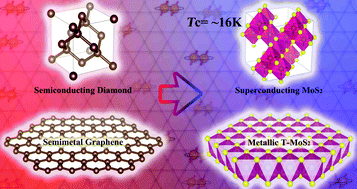Face-centered cubic MoS2: a novel superconducting three-dimensional crystal more stable than layered T-MoS2†
Abstract
Beyond graphene, MoS2 has been intensively studied because of its unique properties. To date, several distinct isomers of MoS2 have been experimentally synthesized. These include semiconducting H-MoS2 and metal T-MoS2 as well as topological insulating T′-MoS2 but only in van der Waals layered materials. Here we authenticate a previously unknown phase of three-dimensional Kagome MoS2 in the face-centered cubic (FCC) space group Fd![[3 with combining macron]](https://www.rsc.org/images/entities/char_0033_0304.gif) m using first-principles calculations. We show that the FCC-MoS2 is a Bardeen–Cooper–Schrieffer superconductor with a relatively high transition temperature (∼16.16 K) higher than that (∼12 K) of pristine 2Ha-MoS2 recently synthesized in experiments. The mechanism for superconducting in this crystal originates from the high s–p–d band hybridizations compatible with the cubic lattice symmetry in the vicinity of the Fermi level. Remarkably, FCC-MoS2 is ∼33.51 meV per atom lower and thermally more stable than the layered T-MoS2. Pure FCC-MoS2 may be prepared by the removal of Ga atoms from the single crystal GaMo4S8, thus holding great promise for superconducting device applications and stimulating further efforts on transition metal-based superconducting materials.
m using first-principles calculations. We show that the FCC-MoS2 is a Bardeen–Cooper–Schrieffer superconductor with a relatively high transition temperature (∼16.16 K) higher than that (∼12 K) of pristine 2Ha-MoS2 recently synthesized in experiments. The mechanism for superconducting in this crystal originates from the high s–p–d band hybridizations compatible with the cubic lattice symmetry in the vicinity of the Fermi level. Remarkably, FCC-MoS2 is ∼33.51 meV per atom lower and thermally more stable than the layered T-MoS2. Pure FCC-MoS2 may be prepared by the removal of Ga atoms from the single crystal GaMo4S8, thus holding great promise for superconducting device applications and stimulating further efforts on transition metal-based superconducting materials.



 Please wait while we load your content...
Please wait while we load your content...